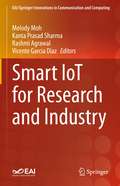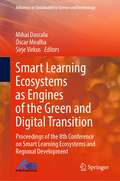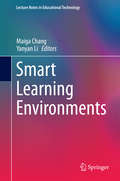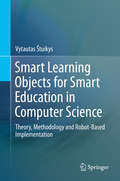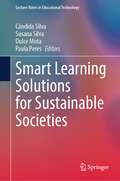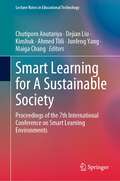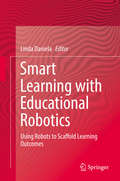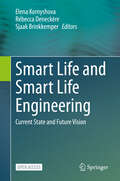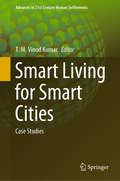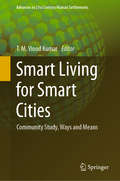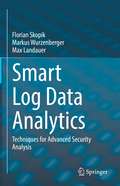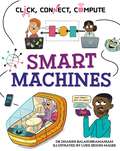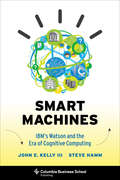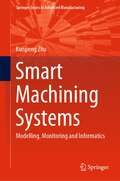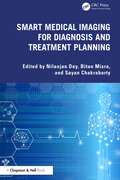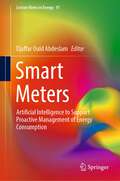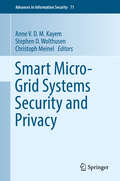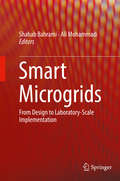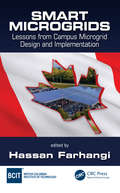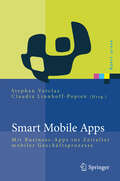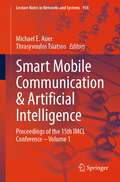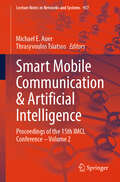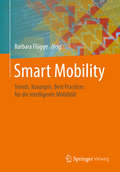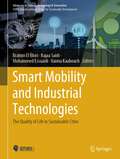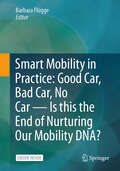- Table View
- List View
Smart IoT for Research and Industry (EAI/Springer Innovations in Communication and Computing)
by Vicente Garcia Diaz Rashmi Agrawal Melody Moh Kanta Prasad SharmaThis book covers a variety of smart IoT applications for industry and research. For industry, the book is a guide for considering the real-time aspects of automation of application domains. The main topics covered in the industry section include real-time tracking and navigation, smart transport systems and application for GPS domains, modern electric grid control for electricity industry, IoT prospectives for modern society, IoT for modern medical science, and IoT automation for Industry 4.0. The book then provides a summary of existing IoT research that underlines enabling technologies, such as fog computing, wireless sensor networks, data mining, context awareness, real-time analytics, virtual reality, and cellular communications. The book pertains to researchers, outcome-based academic leaders, as well as industry leaders.
Smart Learning Ecosystems as Engines of the Green and Digital Transition: Proceedings of the 8th Conference on Smart Learning Ecosystems and Regional Development (Advances in Sustainability Science and Technology)
by Óscar Mealha Sirje Virkus Mihai DascaluThe book brings together the contributions of the 8th International Conference on Smart Learning Ecosystems and Regional Development aimed at promoting reflection and discussion on the relevance of smart learning ecosystems for regional development and social innovation (e.g., schools, campuses, working places, informal learning contexts) and on how the effectiveness of the relation of citizens and smart ecosystems can be boosted. This forum is interested in understanding how technology-mediated instruments can foster the citizen’s engagement with learning ecosystems and territories, namely by understanding innovative human-centric design and development models/techniques, education/training practices, informal social learning, innovative citizen-driven policies, technology-mediated experiences, and their impact. This set of concerns contributes to fostering the social innovation sectors and ICT, economic development, and deployment strategies alongside new policies for smarter proactive citizens.
Smart Learning Environments
by Yanyan Li Maiga ChangThis book addresses main issues concerned with the future learning, learning and academic analytics, virtual world and smart user interface, and mobile learning. This book gathers the newest research results of smart learning environments from the aspects of learning, pedagogies, and technologies in learning. It examines the advances in technology development and changes in the field of education that has been affecting and reshaping the learning environment. Then, it proposes that under the changed technological situations, smart learning systems, no matter what platforms (i. e. , personal computers, smart phones, and tablets) they are running at, should be aware of the preferences and needs that their users (i. e. , the learners and teachers) have, be capable of providing their users with the most appropriate services, helps to enhance the users' learning experiences, and to make the learning efficient.
Smart Learning Objects for Smart Education in Computer Science
by Vytautas ŠtuikysThis monograph presents the challenges, vision and context to design smart learning objects (SLOs) through Computer Science (CS) education modelling and feature model transformations. It presents the latest research on the meta-programming-based generative learning objects (the latter with advanced features are treated as SLOs) and the use of educational robots in teaching CS topics. The introduced methodology includes the overall processes to develop SLO and smart educational environment (SEE) and integrates both into the real education setting to provide teaching in CS using constructivist and project-based approaches along with evaluation of pedagogic outcomes. Smart Learning Objects for Smart Education in Computer Science will appeal to researchers in CS education particularly those interested in using robots in teaching, course designers and educational software and tools developers. With research and exercise questions at the end of each chapter students studying CS related courses will find this work informative and valuable too.
Smart Learning Solutions for Sustainable Societies (Lecture Notes in Educational Technology)
by Cândida Silva Susana Silva Dulce Mota Paula PeresThis book showcases research and project results on technology, smart learning, and sustainability education and analyzes smart learning solutions for lifelong learning. It discusses their impact and potential for transfer and scaling and reviews how real solutions perform in the real world. Sustainable societies are built on twenty-first-century skills. Attaining the United Nations' Sustainable Development Goals requires a focus on a new set of knowledge, skills, and attitudes, as well as novel and smart strategies that leverage state-of-the-art technologies and make these skillsets widely available in our societies to all groups of people, at any time in their lives, in professional as well as academic settings. This book serves as a helpful resource for researchers, academics, practitioners, and consultants from around the world who are involved in the study, management and development of educational technology, smart learning, sustainability education, and related issues.
Smart Learning for A Sustainable Society: Proceedings of the 7th International Conference on Smart Learning Environments (Lecture Notes in Educational Technology)
by Kinshuk Maiga Chang Junfeng Yang Dejian Liu Ahmed Tlili Chutiporn AnutariyaThis book collects the proceedings of the 7th International Conference on Smart Learning Environments (ICSLE2023), held in Bangkok, Thailand, as a hybrid conference from 31st Aug to 1st Sep 2023. The proceedings focus on the interplay between pedagogy and technology, and their fusion towards the advancement of smart learning for a sustainable society. This book covers topics such as: artificial intelligence (AI) and smart technologies in education, innovative applications of smart learning, pedagogy, learning approaches and instructional design, online and digital learning spaces, and lessons learned from the COVID-19 pandemic. It serves as a useful reference for stakeholders in the field of education who are interested in emerging technologies and their applications in smart learning, such as researchers, postgraduate students, undergraduate students, as well as policy makers.
Smart Learning with Educational Robotics: Using Robots to Scaffold Learning Outcomes
by Linda DanielaThis book will offer ideas on how robots can be used as teachers' assistants to scaffold learning outcomes, where the robot is a learning agent in self-directed learning who can contribute to the development of key competences for today's world through targeted learning - such as engineering thinking, math, physics, computational thinking, etc. starting from pre-school and continuing to a higher education level. Robotization is speeding up at the moment in a variety of dimensions, both through the automation of work, by performing intellectual duties, and by providing support for people in everyday situations. There is increasing political attention, especially in Europe, on educational systems not being able to keep up with such emerging technologies, and efforts to rectify this. This edited volume responds to this attention, and seeks to explore which pedagogical and educational concepts should be included in the learning process so that the use of robots is meaningful from the point of view of knowledge construction, and so that it is safe from the technological and cybersecurity perspective.
Smart Life and Smart Life Engineering: Current State and Future Vision
by Sjaak Brinkkemper Elena Kornyshova Rébecca DeneckèreThis open access book defines the field of Smart Life and Smart Life Engineering, identifying a clear scope of what constitutes “smart” in the context of digital technologies, develops a cross-field perspective, provides insights into various related disciplines, and offers illustrative examples of existing works in the field. To this end, it contains thirteen chapters divided into four parts: “Fundamentals of Smart Life and Smart Life Engineering” begins with an exploration of the concept of Smart Life, defines a detailed taxonomy of smart applications and their evolution over time, and, finally, delivers a comprehensive review of social, behavioral, and ethical considerations. Next, “Conceptual Contributions to Smart Life” explores innovative ideas in smart environment, smart home, smart city, and smart tourism. Subsequently, “Smart Life Applications” examines real-world implementations and their impact on various domains including viticulture, elevators, and overtourism. Eventually, “Experience Reports of Smart Life Applications” presents smart city experiences of the cities of Leuven and Monserrate respectively. Written for researchers and industrial professionals from a very large set of fields, this book explores the fascinating domain of smart technologies and their impact on our daily lives and brings together the works around societal, methodological, and technological aspects of Smart Life.
Smart Living for Smart Cities: Case Studies (Advances in 21st Century Human Settlements)
by T. M. Vinod KumarThis book, based on extensive international collaborative research, highlights the state-of-the-art design of “smart living” for metropolises, megacities, and metacities, as well as at the community and neighbourhood level. Smart living is one of six main components of smart cities, the others being smart people, smart economy, smart environment, smart mobility and smart governance. Smart living in any smart city can only be designed and implemented with active roles for smart people and smart city government, and as a joint effort combining e-Democracy, e-Governance and ICT-IoT systems. In addition to using information and communication technologies, the Internet of Things, Internet of Governance (e-Governance) and Internet of People (e-Democracy), the design of smart living utilizes various domain-specific tools to achieve coordinated, effective and efficient management, development, and conservation, and to improve ecological, social, biophysical, psychological and economic well-being in an equitable manner without compromising the sustainability of development ecosystems and stakeholders. This book presents case studies covering more than 10 cities and centred on domain-specific smart living components. The book is issued in two volumes. and this volume focus on city studies.
Smart Living for Smart Cities: Community Study, Ways and Means (Advances in 21st Century Human Settlements)
by T. M. Vinod KumarThis book, based on extensive international collaborative research, highlights the state-of-the-art design of smart living for metropolises, megacities, and metacities, as well as at the community and neighbourhood level. Smart living is one of six main components of smart cities, the others being smart people, smart economy, smart environment, smart mobility and smart governance. Smart living in any smart city can only be designed and implemented with active roles for smart people and smart city government, and as a joint effort combining e-Democracy, e-Governance and ICT-IoT systems. In addition to using information and communication technologies, the Internet of Things, Internet of Governance (e-Governance) and Internet of People (e-Democracy), the design of smart living utilizes various domain-specific tools to achieve coordinated, effective and efficient management, development, and conservation, and to improve ecological, social, biophysical, psychological and economic well-being in an equitable manner without compromising the sustainability of development ecosystems and stakeholders. This book presents case studies covering more than 10 cities and centred on domain-specific smart living components. The book is issued in two volumes and this volume focus on community studies and ways and means.
Smart Log Data Analytics: Techniques for Advanced Security Analysis
by Florian Skopik Markus Wurzenberger Max LandauerThis book provides insights into smart ways of computer log data analysis, with the goal of spotting adversarial actions. It is organized into 3 major parts with a total of 8 chapters that include a detailed view on existing solutions, as well as novel techniques that go far beyond state of the art. The first part of this book motivates the entire topic and highlights major challenges, trends and design criteria for log data analysis approaches, and further surveys and compares the state of the art. The second part of this book introduces concepts that apply character-based, rather than token-based, approaches and thus work on a more fine-grained level. Furthermore, these solutions were designed for “online use”, not only forensic analysis, but also process new log lines as they arrive in an efficient single pass manner. An advanced method for time series analysis aims at detecting changes in the overall behavior profile of an observed system and spotting trends and periodicities through log analysis. The third part of this book introduces the design of the AMiner, which is an advanced open source component for log data anomaly mining. The AMiner comes with several detectors to spot new events, new parameters, new correlations, new values and unknown value combinations and can run as stand-alone solution or as sensor with connection to a SIEM solution. More advanced detectors help to determines the characteristics of variable parts of log lines, specifically the properties of numerical and categorical fields.Detailed examples throughout this book allow the reader to better understand and apply the introduced techniques with open source software. Step-by-step instructions help to get familiar with the concepts and to better comprehend their inner mechanisms. A log test data set is available as free download and enables the reader to get the system up and running in no time.This book is designed for researchers working in the field of cyber security, and specifically system monitoring, anomaly detection and intrusion detection. The content of this book will be particularly useful for advanced-level students studying computer science, computer technology, and information systems. Forward-thinking practitioners, who would benefit from becoming familiar with the advanced anomaly detection methods, will also be interested in this book.
Smart Machines (Click, Connect, Compute #2)
by Dharini BalasubramaniamSmart machine fundamentals, using clear, expert explanations and comic illustrations to spark interest and enthusiasm in the next generation of computer scientists!Click, Connect, Compute: Smart Machines uncovers how machine that can learn are created and how they operate. Readers will discover the meaning of Artificial Intelligence (AI), the benefits of teamwork in tech, and the role that the 'Internet of Things' plays in helping homes, hospitals and cities run. And the end of the book fast-forwards to the future of computer science, robotics and AI and considers what it might mean to live in a 'smarter' world.Contents: What are smart machines? / Smart machine fundamentals / Putting together a smart machine / What's AI got to do with it? / Data's part to play / The Internet of Things (IoT) / Making smart spaces / Are robots smart? / The rise of smart machines / Just how smart are smart machines? / The rights and wrongs of using smart machines / The future of smart machines / Pioneer portraits / Further information / Glossary / Quiz yourself! / IndexThe Click, Connect, Compute series untangles the computer science web and teaches children about the essentials of computer software, hardware and digital literacy as well as discussing the ethics surrounding this evolving field. Featuring fun, friendly comic strip illustrations, pioneer bios and a quiz, this is a perfect read for children aged 8+.Books in the series: Computer Science Essentials / Data, Big and Small / Smart Machines / The Languages of ProgrammingWritten in a clear, thoughtful way by computer science expert, Dr. Dharini Balasubramaniam, a strong advocate for ethics and education in her field.
Smart Machines: IBM's Watson and the Era of Cognitive Computing (Columbia Business School Publishing)
by Steve Hamm John Kelly IIIWe are crossing a new frontier in the evolution of computing and entering the era of cognitive systems. The victory of IBM's Watson on the television quiz show Jeopardy! revealed how scientists and engineers at IBM and elsewhere are pushing the boundaries of science and technology to create machines that sense, learn, reason, and interact with people in new ways to provide insight and advice.In Smart Machines, John E. Kelly III, director of IBM Research, and Steve Hamm, a writer at IBM and a former business and technology journalist, introduce the fascinating world of "cognitive systems" to general audiences and provide a window into the future of computing. Cognitive systems promise to penetrate complexity and assist people and organizations in better decision making. They can help doctors evaluate and treat patients, augment the ways we see, anticipate major weather events, and contribute to smarter urban planning. Kelly and Hamm's comprehensive perspective describes this technology inside and out and explains how it will help us conquer the harnessing and understanding of "big data," one of the major computing challenges facing businesses and governments in the coming decades. Absorbing and impassioned, their book will inspire governments, academics, and the global tech industry to work together to power this exciting wave in innovation.
Smart Machining Systems: Modelling, Monitoring and Informatics (Springer Series in Advanced Manufacturing)
by Kunpeng ZhuThis book provides the tools to enhance the precision, automation and intelligence of modern CNC machining systems. Based on a detailed description of the technical foundations of the machining monitoring system, it develops the general idea of design and implementation of smart machining monitoring systems, focusing on the tool condition monitoring system. The book is structured in two parts. Part I discusses the fundamentals of machining systems, including modeling of machining processes, mathematical basics of condition monitoring and the framework of TCM from a machine learning perspective. Part II is then focused on the applications of these theories. It explains sensory signal processing and feature extraction, as well as the cyber-physical system of the smart machining system. Its utilisation of numerous illustrations and diagrams explain the ideas presented in a clear way, making this book a valuable reference for researchers, graduate students and engineers alike.
Smart Medical Imaging for Diagnosis and Treatment Planning
by Nilanjan Dey, Bitan Misra, and Sayan ChakrabortyThis book presents advanced research on smart health technologies, focusing on the innovative transformations in diagnosis and treatment planning using medical imaging and data analysed by data science techniques. It shows how smart health technologies leverage artificial intelligence (AI) and big data analytics to provide more accurate and efficient diagnosis and treatment planning. In search for innovative and novel methods and techniques for health technologies and medical data processing, the book • Discusses applications of Artificial Intelligence, Data Science, Machine Learning, Deep Learning, the Internet of Things, Big Data, Cloud Computing;• Includes use of electronic patient records in healthcare, analysis of big data in medical diagnosis, reliability, and challenges of EPR and EHR in smart healthcare;• Explores evolving techniques for smart healthcare, its application in medical imaging and prediction in the fields of treatment planning;• Provides recent studies in AI-driven healthcare technologies and medical imaging to outline insight into smart healthcare technologies;• Discusses the role of big data in smart healthcare, computing techniques for healthcare for medical diagnosis and treatment planning;• Encompasses the ethical and legal challenges of using smart healthcare and medical data.This book serves as a valuable reference for researchers working on smart health technologies. Researchers of medical imaging, artificial intelligence, and data science along with healthcare domain will find it a great resource as well.
Smart Meters: Artificial Intelligence to Support Proactive Management of Energy Consumption (Lecture Notes in Energy #97)
by Djaffar Ould AbdeslamThis book describes how equipping buildings with smart meters is essential to improve the prediction of energy costs within smart grids and to help end-users optimize their energy consumption. The book reports on the results of the European Upper Rhine INTERREG project SMI (www.smi.uha.fr), which connects artificial intelligence and micro-societal analysis. It is multidisciplinary and addresses the following aspects: social, legal, environmental, and technical.One of the critical factors for the transition to clean energy is the flexibility of the power grid. A flexible grid requires a constant flow of data about the network and its demand, on the other hand, clients who produce electrical power can be an active part of the demand response if they are informed about the power needs of their appliances.“If you cannot measure it, you cannot improve it.” This common management saying also holds true for the area energy efficiency. Without a clear understanding of their energy usage, consumers are unable to take steps to reduce their consumption. A new intelligent tool is presented that is more efficient, safe, and acceptable to consumers. Thus, users of this intelligent tool will be able to collect and predict the consumption of their electrical appliances. At the same time, the consumption information is anonymized before being relayed to the energy supplier. In parallel, new techniques will be evaluated to improve the security level of the smart meter in a highly heterogeneous network.
Smart Micro-Grid Systems Security and Privacy (Advances in Information Security #71)
by Christoph Meinel Anne V. Kayem Stephen D. WolthusenThis book is centered on Smart grids and micro-grids, as a cost-effective method of ensuring fair and equitable access to power in urban areas. It also considers scenarios where deploying smart grids can be both cost-prohibitively expensive and logistically challenging. Deploying smart microgrids instead, offers a reliable power solution but, as is the case in smart grids, a key issue is guaranteeing usability, trust, and reliability while protecting against energy theft. This book considers aspects such as state estimation, capacity planning, demand forecasting, price signals, and demand management with respect to energy theft. Straight-forward approaches to provoking energy theft on smart grids and micro-grids include mis-recordings power consumption/generation information and exposures of personally identifiable information or sensitive information. Attack models based on mis-recorded generation and/or consumption data and exposure of personally identifiable information, are also studied. In each case, countermeasures are proposed to circumvent the power theft attacks raised. Researchers in Smart Micro-grids security, cyber-physical systems, and critical infrastructure will want to purchase this book as a reference. Professionals, Researchers, Academics and students working in security general and Security of Critical Infrastructure, Privacy, and Data Sharing will also want to purchase this book as a reference.
Smart Microgrids: From Design to Laboratory-Scale Implementation
by Shahab Bahrami Ali MohammadiIn this book the authors first provide a comprehensive survey on the available studies on control, management, and optimization strategies in AC and DC microgrids. The authors then provide the design of a laboratory-scale microgrid system. Finally, a real-world implementation of the deigned framework is provided. This book paves the way for researchers working on the smart microgrids spread over the fields of electrical engineering, power systems, and smart infrastructures. Furthermore, it provides the readers with a comprehensive insight to understand an in-depth big picture of smart microgrids as well as an all-inclusive framework for laboratory-scale implementation of a microgrid. It is suitable for senior undergraduate students, graduate students who are interested in research in areas related to future smart grids and microgrids, and the researchers working in the related areas. This book also can be used as a reference book for researchers who want to develop laboratories on smart microgrids for future research.
Smart Microgrids: Lessons from Campus Microgrid Design and Implementation
by Russell L. HermanThe utility sector’s transition to renewable energy and the smart grid has already begun. The first step towards smart grid is microgrid, which is a smaller electricity grid with access to all the essential assets of a larger grid. This book provides a glimpse into an actual microgrid project. It supplies a system-level approach to the design of smart Microgrids, covering the entire design process—from roadmap to realization. Detailing lessons learned and pitfalls to avoid in Microgrid technology, the book provides an interdisciplinary approach to design and problem solving for smart microgrids.
Smart Mobile Apps: Mit Business-Apps ins Zeitalter mobiler Geschäftsprozesse
by Stephan Verclas Claudia Linnhoff-PopienMobile Apps - Programme, die auf Smartphones ausgeführt werden - sind derzeit fast nur bei Konsumenten erfolgreich. Ein echtes App-Konzept für den Business-Markt fehlt nach wie vor. Die Autoren zeigen in dem Band den Weg zu intelligenten Business-Apps für mobile Geschäftsprozesse, mit deren Hilfe Kunden zeitnah und individuell informiert werden können. Die Autoren betrachten Fragen der Anwendung, der Technologie und des Marktes und berücksichtigen auch Cloud-Lösungen.
Smart Mobile Communication & Artificial Intelligence: Proceedings of the 15th IMCL Conference – Volume 1 (Lecture Notes in Networks and Systems #936)
by Michael E. Auer Thrasyvoulos TsiatsosInteractive mobile technologies are today the core of many—if not all—fields of society. Not only the younger generation of students expects a mobile working and learning environment. And nearly daily new ideas, technologies, and solutions boost this trend. To discuss and assess the trends in the interactive mobile field are the aims connected with the 15th International Conference on Interactive Mobile Communication, Technologies, and Learning (IMCL2023), which was held 9–10 November 2023. Since its beginning in 2006, this conference is devoted to new approaches in interactive mobile technologies with a focus on learning. Nowadays, the IMCL conferences are a forum of the exchange of new research results and relevant trends as well as the exchange of experiences and examples of good practice. Interested readership includes policy makers, academics, educators, researchers in pedagogy and learning theory, schoolteachers, learning Industry, further education lecturers, etc.
Smart Mobile Communication & Artificial Intelligence: Proceedings of the 15th IMCL Conference – Volume 2 (Lecture Notes in Networks and Systems #937)
by Michael E. Auer Thrasyvoulos TsiatsosInteractive mobile technologies are today the core of many—if not all—fields of society. Not only the younger generation of students expects a mobile working and learning environment. And nearly daily new ideas, technologies, and solutions boost this trend. To discuss and assess the trends in the interactive mobile field are the aims connected with the 15th International Conference on Interactive Mobile Communication, Technologies, and Learning (IMCL2023), which was held 9–10 November 2023. Since its beginning in 2006, this conference is devoted to new approaches in interactive mobile technologies with a focus on learning. Nowadays, the IMCL conferences are a forum of the exchange of new research results and relevant trends as well as the exchange of experiences and examples of good practice. Interested readership includes policy makers, academics, educators, researchers in pedagogy and learning theory, schoolteachers, learning Industry, further education lecturers, etc.
Smart Mobility
by Barbara FlüggeDas Herausgeberwerk bietet einen umfassenden Zugang zum Trendthema Smart Mobility: ausgehend von sozio-ökologischen und sozio-ökonomischen Aspekten der Mobilität, den Anforderungen von Anbietern und Nachfragern bis hin zu Mobilitätsansprüchen ganzer Ökosysteme und der Anwendbarkeit digitaler Lösungen für die Lebensbereiche jedes Einzelnen. Das Buch setzt wirkungsvoll die Ausgangssituation im Bereich Mobilität in Kontext mit den unterschiedlichsten Nutzungsszenarien und Initiativen. Die Leserschaft erhält einen Fahrplan für die Mobilität in Zeiten der Digitalisierung: Bausteine Intelligenter Mobilität (BIM), ein Vorgehensmodell und eine Reihe praxisorientierter Handlungsempfehlungen erleichtern die Analyse-, Planungs- und Umsetzungsphasen von Mobilitätsvorhaben.Die Beschreibungen erfolgen bewusst anschaulich und nachvollziehbar durch Checklisten und Anleitungen. Damit richtet sich das Buch an alle Entscheider, Innovationstreiber und Vordenker aus der Praxis, die sich mit dem Thema Mobilität beschäftigen – sei es im Personen- oder Frachtverkehr.
Smart Mobility and Industrial Technologies: The Quality of Life in Sustainable Cities (Advances in Science, Technology & Innovation)
by Mohammed Essaaidi Rajaa Saidi Brahim El Bhiri Naima KaabouchThis book discusses many issues related to the impact of advanced technologies on quality of human life. It covers several areas and use cases that illustrate how technologies could be harnessed to solve all kinds of humanity issues in areas as diverse as education, health care, industry, agriculture, mobility, etc. Specially, it aims at establishing the vital link between advances in technology and sustainable development to magnify the benefits. This book covers a wide range of audience including academic/research, professors, scientists, and engineers working in different fields, comprising engineering, sustainability, as well as government and international organizations officials interested in sustainable planning. This is done through a set of selected papers from those presented to 4th International Conference on Advanced Technologies for Humanity (ICATH'2022) which was organized by the Moroccan School of Engineering Sciences (EMSI) in collaboration with national and international institutions. ICATH22 was held in Marrakech, from November 11 to 12, 2022. Key topics showcasing how technology can serve humanity in different ways and facets of human life, activities, and challenges are covered in depth through the chapters of this book which are presented in four different sections, namely:1. Advanced Technologies for smart Mobility in Smart Cities.2. Emerging Technologies for Connectivity in Sustainable Cities.3. Transitioning to Sustainable Industrial Engineering. 4. Technology for Human Sciences as Key Components of Sustainability.
Smart Mobility in Practice: Good Car, Bad Car, No Car – Is this the End of Nurturing Our Mobility DNA?
by Barbara FlüggeThis non-fictional, yet storytelling, book questions the role of cars and their impact, both for now and in the future. It is not enough to just consider autonomous driving, driving bans in Europe, and combustion engines. Our future and the future of our cities and country living depend on how we can coordinate different needs and different means. Finally, we ask ourselves: What is the status of the car today and in the future? Are we living and working in vehicles more than ever? And who benefits from autonomous driving and what are we giving up for it? In this book, the editor's work illustrates and critically assesses the role of cars. It showcases project examples and introduces easy to use checklists. The authors show how the car influences our business and private lives, and how the car stimulates our appetite for adventures, recreation, and survival. Emerging throughout more than a century, purposefully deployed, and innovativelyused, the automobile grew into our mobility DNA beyond horsepower and equipment. The car has been evolving into an adventure space, a survival and a growth space. The editor and authoring team present innovative services, digital use cases and smart data that are worth considering. The concept of Smart Mobility offers the possibility to retrieve the appropriate means of transport for individual and freight traffic in a forward-looking, digital, and intermodal way. Smart Mobility in practice: Good car, bad car, no car by DoktorB Barbara Fluegge and team is aimed at decision-makers and entrepreneurs, as well as project managers and their teams, in the context of smart city and digitail transformation projects. Numerous checklists and a comprehensive glossary make the book an important tool for practical use in pre- and post-preparation of projects and lectures in the field of Smart Mobility, Smart City, Smart Regions. Business Development and Digital Humanism.
